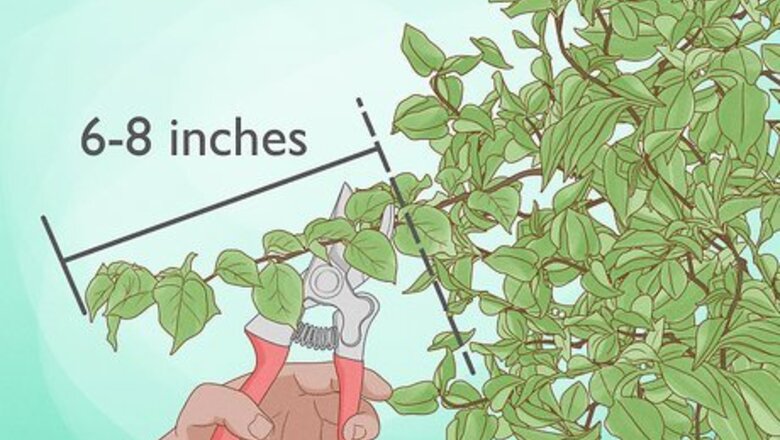
views
- Snip off 6–8 inches (15–20 cm) of a parent plant, prune its leaves, and dip the stem into rooting hormone (also called rooting acid).
- Plant your stem in well-draining soil, water it, cover it with a plastic bag, and wait for it to sprout (this typically takes 6-8 weeks).
- After 3-6 months, prepare your bougainvillea for your garden by gradually exposing it to sunlight and keeping it in moderate temperatures.
Taking a Cutting from the Parent Plant
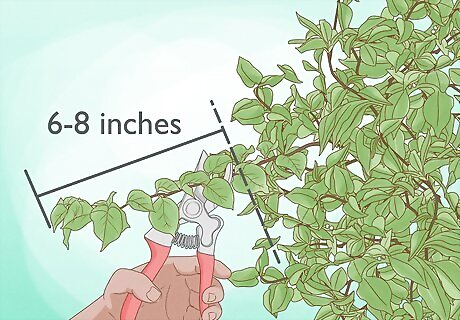
Cut a mature stem to a length of 6–8 inches (15–20 cm). Use a pair of sharp pruning shears to snip the lower end of the stem at a 45 degree angle. Only take healthy cuttings that do not have signs of disease of infestation. Cutting the stem at an angle increases its surface area, allowing it to take up more moisture and nutrients from the planting soil. The cutting should have at least 7 nodes on it to produce a healthy plant. Wear gardening gloves and eye protection when you take a cutting. Take semi-ripe or hardwood for your cuttings rather than younger sections that are still green. The best time to take cuttings from bougainvillea is late-spring to mid-summer, when growth is most rapid and abundant. Getting bougainvillea to root can be tricky. Consider taking multiple cuttings to give yourself more than one shot if your first attempt fails. You can cut back as much as a third of the plant's growth without worrying about harming it. Sterilize your gardening tools with rubbing alcohol before and after you take a cutting.
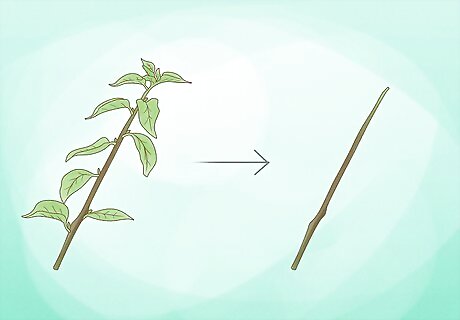
Prune the leaves from the stem. The stem is the only part of the bougainvillea that will take root successfully. Cut away all flowers, leaves, and small offshoots from the slender, woody shaft. Trim and discard any sections that are still green, as these are less likely to survive when planted. Make sure you remove at least half of the leaves from the stem. This will help ensure that all of the plant’s resources are being used to form new roots. If you’re not planning on rooting your bougainvillea right away, wrap your cuttings in a damp paper towel and store them in the refrigerator in an airtight plastic bag. This will keep them from drying out for 1-2 weeks.
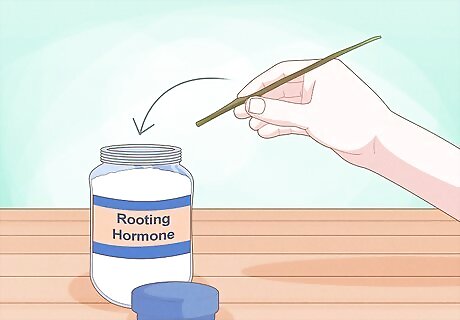
Dip the cut end in rooting hormone. Wet the bottom of the stem and press it into a container of powdered rooting hormone. Coat the underside thoroughly, but avoid caking or clumping. To remove excess powder, tap the stem lightly with your fingertip. Rooting hormone can be found at most major gardening centers, greenhouses, and plant nurseries. It’s also sometimes known as “rooting acid.” You can also try making your own rooting hormone at home using ingredients like apple cider vinegar, cinnamon, honey, or crushed Aspirin.
Planting the Cutting
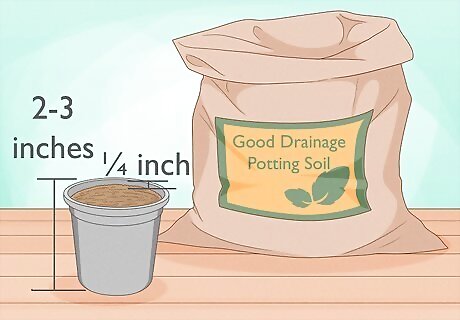
Fill a small container with a well-drained soil. For best results, purchase a growing medium designed specifically for propagating from seeds and cuttings. You can also use a mixture of commercial potting soil, organic garden compost, and sand. Leave about ¼ inch (0.64 cm) at the top of the container to allow space for watering. When using a packaged soil, consider mixing in ⅓ perlite, vermiculite, or horticultural grit to promote proper drainage. You’ll only be caring for your bougainvillea in this container until it takes root, so a pot as small as 2–3 inches (5.1–7.6 cm) will work just fine.
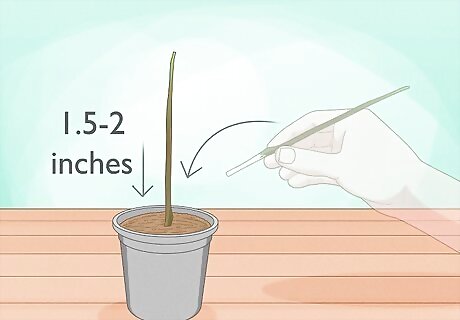
Insert the cutting into the soil. Sink the stem 1.5–2 inches (3.8–5.1 cm) below the surface of the soil to ensure that it’s anchored firmly. If you’re working with a denser soil mixture and you’re worried about damaging the stem, it may help to first open up a narrow hole using a pencil or similar object. Inserting the stem into the soil at a slight angle may help more of the existing nodes sprout into roots. Use only one cutting per pot to provide plenty of room for growth and prevent competition.
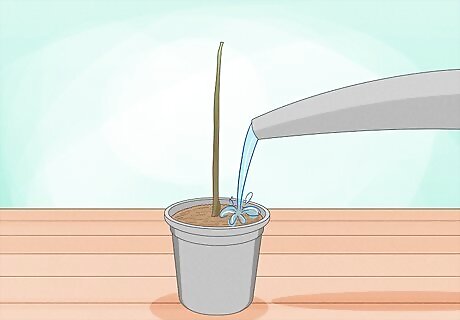
Water the newly planted cutting thoroughly. Use enough water to moisten the surface of the soil without oversaturating it. After watering, allow the cutting to sit undisturbed. A healthy drink will encourage it to begin putting down new roots. Be careful not to overwater your bougainvillea cutting. Too much moisture could inhibit the rooting process, or even lead to more harmful complications like rotting or fungal disease.
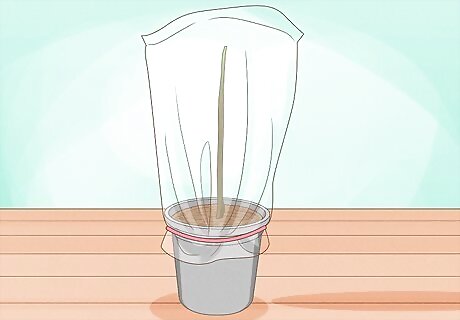
Cover the potted cutting with a plastic bag. The surrounding layer of plastic will create a miniature greenhouse effect, trapping in humidity. In just a few weeks, the abundance of moisture will help the plant begin growing on its own. Once it’s covered, pick out a cool, shady spot inside your home away from direct heat or sunlight to store the cutting. Seal the bag by tying or zipping, if possible. Otherwise, it should be okay to simply drape the plastic cover over the top of the pot and make sure the bottom is weighted and secure. You can also use a cloche or coldframe, if you have access to one.
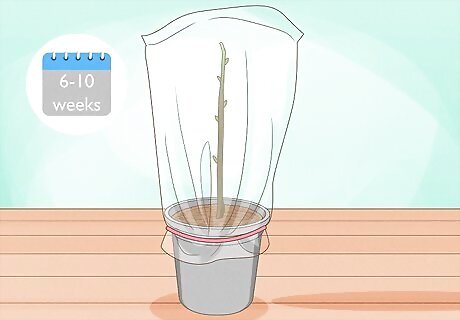
Look for the cutting to begin sprouting within 6-10 weeks. You’ll know your bougainvillea cutting has taken root when small green leaves begin to form along the stem. In the meantime, avoid removing the bag or otherwise disturbing the plant. Doing so could inhibit the rooting process. In most cases, it’s better to wait until numerous offshoots begin appearing along the stem than to risk uprooting it too early.
Preparing Developing Plants for a Container or Garden
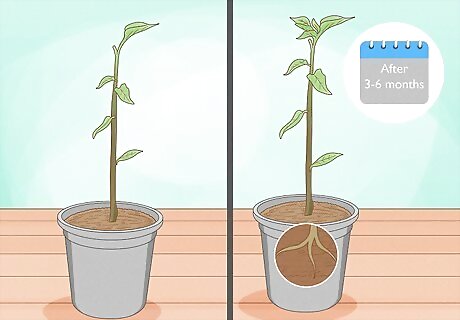
Allow the cutting to continue rooting until 4-6 leaves have appeared. This may take anywhere from 3-6 months, depending on the state of the cutting and your exact soil conditions. Once the stem begins producing foliage again, it will be safe to repot it in a larger container or transplant it to your garden. There’s no need to water the cutting the way you would a seedling, as the roots are not yet fully developed.
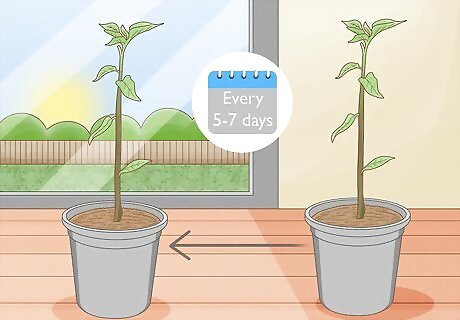
Introduce the rooted cutting to full sunlight gradually. Most veteran gardeners recommend a “hardening-off” phase that lasts at least 2 weeks. To do this, simply move the plant to an area with slightly more direct sunlight every 5-7 days. A slow process of acclimation will help it adapt to its new environment and increase its chances of survival. Situating your bougainvillea in direct sunlight before it’s ready could kill it, leaving you with nothing to show for your efforts.
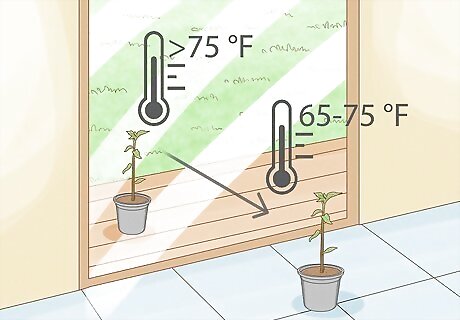
Keep the cutting within 65–75 °F (18–24 °C). During this time, you’ll want to limit the plant’s exposure to especially warm or cold conditions. It’s a good idea to bring it inside during the hottest part of the afternoon and in the evening after the sun sets. Rapid fluctuations in temperature can also be hard on young cuttings, even if they’re relatively modest. Bougainvillea is most comfortable at the same temperatures you are. For this reason, the inside of your home will generally be the best place for it.
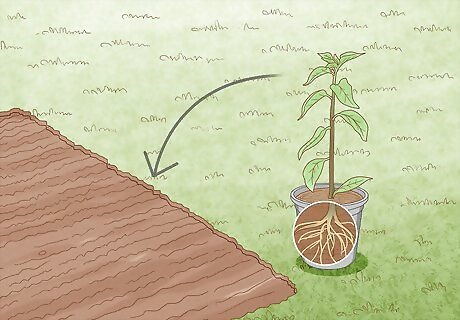
Uproot the cutting and establish it in its new home. Tap the outside of the rooting pot to gently dislodge the compacted soil. Upend the entire pot carefully on your palm, holding the cutting firmly between the fingers of your opposite hand. Your bougainvillea is now ready to be planted in a container or flower bed and continue growing on its own. Plant your bougainvillea in spring or summer so it will have time to establish itself before winter arrives. Your cutting's container or plot should be at least twice as large as its growing root system to give it plenty of room to spread out comfortably. Once established, bougainvillea doesn’t respond well to having its roots disturbed. If you want to transplant a growing shrub a second time, it may be best to just purchase a new one.




















Comments
0 comment